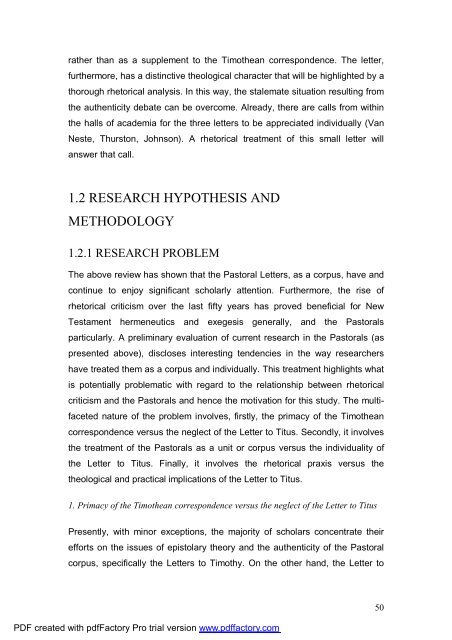A Text centred rhetorical analysis of Paul's Letter to Titus
A Text centred rhetorical analysis of Paul's Letter to Titus
A Text centred rhetorical analysis of Paul's Letter to Titus
You also want an ePaper? Increase the reach of your titles
YUMPU automatically turns print PDFs into web optimized ePapers that Google loves.
ather than as a supplement <strong>to</strong> the Timothean correspondence. The letter,<br />
furthermore, has a distinctive theological character that will be highlighted by a<br />
thorough <strong>rhe<strong>to</strong>rical</strong> <strong>analysis</strong>. In this way, the stalemate situation resulting from<br />
the authenticity debate can be overcome. Already, there are calls from within<br />
the halls <strong>of</strong> academia for the three letters <strong>to</strong> be appreciated individually (Van<br />
Neste, Thurs<strong>to</strong>n, Johnson). A <strong>rhe<strong>to</strong>rical</strong> treatment <strong>of</strong> this small letter will<br />
answer that call.<br />
1.2 RESEARCH HYPOTHESIS AND<br />
METHODOLOGY<br />
1.2.1 RESEARCH PROBLEM<br />
The above review has shown that the Pas<strong>to</strong>ral <strong>Letter</strong>s, as a corpus, have and<br />
continue <strong>to</strong> enjoy significant scholarly attention. Furthermore, the rise <strong>of</strong><br />
<strong>rhe<strong>to</strong>rical</strong> criticism over the last fifty years has proved beneficial for New<br />
Testament hermeneutics and exegesis generally, and the Pas<strong>to</strong>rals<br />
particularly. A preliminary evaluation <strong>of</strong> current research in the Pas<strong>to</strong>rals (as<br />
presented above), discloses interesting tendencies in the way researchers<br />
have treated them as a corpus and individually. This treatment highlights what<br />
is potentially problematic with regard <strong>to</strong> the relationship between <strong>rhe<strong>to</strong>rical</strong><br />
criticism and the Pas<strong>to</strong>rals and hence the motivation for this study. The multi-<br />
faceted nature <strong>of</strong> the problem involves, firstly, the primacy <strong>of</strong> the Timothean<br />
correspondence versus the neglect <strong>of</strong> the <strong>Letter</strong> <strong>to</strong> <strong>Titus</strong>. Secondly, it involves<br />
the treatment <strong>of</strong> the Pas<strong>to</strong>rals as a unit or corpus versus the individuality <strong>of</strong><br />
the <strong>Letter</strong> <strong>to</strong> <strong>Titus</strong>. Finally, it involves the <strong>rhe<strong>to</strong>rical</strong> praxis versus the<br />
theological and practical implications <strong>of</strong> the <strong>Letter</strong> <strong>to</strong> <strong>Titus</strong>.<br />
1. Primacy <strong>of</strong> the Timothean correspondence versus the neglect <strong>of</strong> the <strong>Letter</strong> <strong>to</strong> <strong>Titus</strong><br />
Presently, with minor exceptions, the majority <strong>of</strong> scholars concentrate their<br />
efforts on the issues <strong>of</strong> epis<strong>to</strong>lary theory and the authenticity <strong>of</strong> the Pas<strong>to</strong>ral<br />
corpus, specifically the <strong>Letter</strong>s <strong>to</strong> Timothy. On the other hand, the <strong>Letter</strong> <strong>to</strong><br />
PDF created with pdfFac<strong>to</strong>ry Pro trial version www.pdffac<strong>to</strong>ry.com<br />
50

















